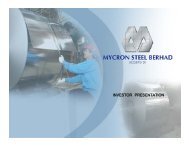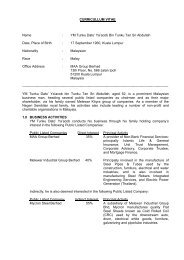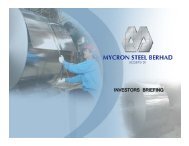Annual Report (Complete) - MYCRON Steel Berhad
Annual Report (Complete) - MYCRON Steel Berhad
Annual Report (Complete) - MYCRON Steel Berhad
Create successful ePaper yourself
Turn your PDF publications into a flip-book with our unique Google optimized e-Paper software.
Notes to the Financial Statements<br />
30 June 2010<br />
(continued)<br />
2. SUMMARY OF SIGNIFICANT ACCOUNTING POLICIES (continued)<br />
(d)<br />
Property, plant and equipment (continued)<br />
(i)<br />
Measurement basis (continued)<br />
Subsequent costs are included in the asset’s carrying amount or recognised as a separate asset, as appropriate,<br />
only when it is probable that future economic benefits associated with the item will flow to the Group and the cost of<br />
the item can be measured reliably. The carrying amount of the replaced part is derecognised. All other repairs and<br />
maintenance are charged to the income statement during the period in which they are incurred.<br />
Surpluses arising on revaluation are dealt with through the asset revaluation reserve account. Any deficit arising is<br />
set-off against the asset revaluation reserve to the extent of a previous increase for the same asset. In all other cases,<br />
a decrease in carrying amount will be charged immediately to the income statement.<br />
Gains and losses on disposals are determined by comparing proceeds with carrying amounts and are included<br />
in the profit/(loss) from operations. On disposal of revalued assets, amounts in revaluation reserve relating to those<br />
assets are transferred to retained earnings.<br />
At each balance sheet date, the Group assesses whether there is any indication of impairment. If such indication<br />
exists, an analysis is performed to assess whether the carrying amount of the asset is fully recoverable. A write-down<br />
is made if the carrying amount exceeds the recoverable amount.<br />
(ii)<br />
Depreciation<br />
Freehold land is not depreciated as it has infinite life. All other property, plant and equipment are depreciated on a<br />
straight line basis to write off the cost or their revalued amounts, to their residual value over their estimated useful lives<br />
as follows:<br />
Buildings<br />
Plant, machinery and electrical installation<br />
Motor vehicles, furniture, fittings and office equipment<br />
Years<br />
50 years<br />
4 – 40 years<br />
10 years<br />
Depreciation on assets under construction commences when the assets are ready for their intended use.<br />
Residual values and useful lives of assets are reviewed, and adjusted if appropriate, at each balance sheet date.<br />
(e)<br />
Financial assets<br />
The Group classifies its financial assets in the following categories: financial assets at fair value through profit or loss, loans<br />
and receivables, held-to-maturity investments and available-for-sale financial assets. The classification depends on the<br />
purpose for which the investments were acquired. Management determines the classification of its financial assets at initial<br />
recognition and re-evaluates this at every reporting date except for financial assets at fair value through profit or loss.<br />
(i)<br />
Loans and receivables<br />
Loans and receivables are non-derivative financial assets with fixed or determinable payments that are not quoted<br />
in an active market. They arise when the Group provides money, goods or services directly to a debtor with no<br />
intention of trading the receivable. They are included in current assets, except for maturities greater than 12 months<br />
after the balance sheet date. These are classified as noncurrent assets. Loans and receivables comprise of “trade<br />
and other receivables” and “deposits, bank and cash balances” in the balance sheet.<br />
(ii)<br />
Available-for-sale financial assets<br />
Available-for-sale financial assets are non-derivatives that are either designated in this category or not classified in<br />
any of the other categories. They are included in non-current assets unless management intends to dispose of the<br />
investment within 12 months of the balance sheet date.<br />
Regular purchases and sales of financial assets are recognised on the trade date – the date on which the Group commits to<br />
purchase or sell the asset. Investments are initially recognised at fair value plus transaction costs that are directly attributable<br />
to their acquisitions for all financial assets not carried at fair value through profit or loss. Financial assets carried at fair value<br />
through profit or loss is initially recognised at fair value, and transaction costs are expensed in the income statement.<br />
Financial assets are derecognised when the rights to receive cash flows from the investments have expired or have been<br />
transferred and the Group has transferred substantially all risks and rewards of ownership.<br />
pg 57 | Mycron <strong>Steel</strong> <strong>Berhad</strong>











